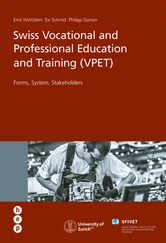3The Swiss education and training system 3The Swiss education and training system VET in Switzerland is closely linked to the other sectors of the education and training system. Illustration 1 provides an overview of this system. It shows that VET is an integral element of this system and that there are various pathways from VET to different types of tertiary education. Illustration 1: Overview of the Swiss education and training system. Source: SERI, 2016 (p. 6) In the following pages, we outline the different sectors of this system.
3.1Compulsory education and baccalaureate schools 3.1Compulsory education and baccalaureate schools In most cantons, compulsory schooling lasts for nine years and is free of charge. Six years of primary education are generally followed by three years of lower secondary education (for the ages of approximately thirteen to sixteen years), which are characterised by performance-based tracks with either basic or more expanded curricula. In order to prepare students for their transition to upper secondary VET, vocational guidance plays a key role in lower secondary education. It is provided both by the teachers and by centres for vocational guidance (Berufsinformationszentren, BIZ). Academically able lower secondary graduates who do not wish to enrol in VET after nine years of compulsory education continue their education at baccalaureate schools, and this leads to the Federal Academic Baccalaureate. This qualification allows direct entry into cantonal universities and into the federal institutes of technology (ETH). After an internship of one year, access is also possible to the Universities of Applied Sciences (UAS). In 2015, only 20% of qualifications at the upper secondary level were Federal Academic Baccalaureates. 3 By international standards, this figure is very low. However, highly selective access to the baccalaureate schools is one of the key reasons why VET in Switzerland also caters to academically very able graduates from lower secondary education.
3.2VET at upper secondary level 3.2VET at upper secondary level VET programmes at upper secondary level prepare learners for three types of qualifications: Federal VET Diploma This qualification can be achieved after three to four years of formal VET. Specifically the VET programmes for trades (e.g. carpentry, electrical wiring) and industry (e.g. mechanical engineering) are four years long. Out of all VET graduates in 2014, approx. 91% achieved a Federal VET Diploma. 4 This qualification prepares for direct labour market entry but also provides access to professional education and training (PET) at the tertiary level. Federal VET Certificate Programmes that lead to this qualification take two years. They mainly cater to students with difficulties in meeting the exigencies of the more demanding programmes for the VET diploma. In principal, this certificate allows one to enrol in the second year of programmes that lead to the VET diploma. This depends, however, on the availability of apprenticeship positions in host companies. In 2014, approx. 9% of all VET graduates achieved a VET certificate. Federal Vocational Baccalaureate Provided they have the support of their host company and they meet the entry requirements, VET students that prepare for the Federal VET Diploma can enrol in additional preparatory classes to study for the Federal Vocational Baccalaureate (FVB). This qualification provides access to the Universities of Applied Sciences (UAS). The FVB has existed, in this form, since 1994, and has contributed considerably to the permeability and the attractiveness of VET for students. Students who have already obtained a Federal VET Diploma can prepare for the FVB during an extra year of full-time or two years of parttime schooling (see section 7 ).
3.3Tertiary education 3.3Tertiary education Tertiary education with particular relevance for VET graduates consists of two segments: professional education (PET / Tertiary B) and the Universities of Applied Sciences (UAS / Tertiary A). PET programmes can be accessed by those with a VET diploma and are generally started some years after graduation, when most students have gained some work experience and start to study on either on a full-time or part-time basis. The so-called college degree programmes (in eight different professional fields) are offered in more school-based form and prepare students for relatively broad occupational fields, such as business administration, healthcare or mechanical engineering. Meanwhile, there are four hundred federal PET examinations at two levels – Federal Diploma Examination (Eidgenössische Berufsprüfung) and Advanced Federal Diploma Examination (höhere Fachprüfung) – most of which prepare students for highly specialised professions. 5 The Universities of Applied Sciences (UAS, Fachhochschulen) offer bachelor programmes and an increasing number of master’s programmes to students with an FVB as well as to graduates from some of the PET programmes (which do not require an FVB). Teaching and research at the UAS is more applied and mainly caters to former VET graduates who have gained considerable work experience. VET graduates who complement their studies with an FVB can also undergo a University Aptitude Test and, if successful, then enrol at a regular, cantonal university or at one of the two federal institutes of technology. The preparatory course for the test lasts one year and is offered by both public and private schools.
4Legal, political and economic aspects of Swiss VPET
4.1Legal framework
4.2Key partners in policymaking and implementation
4.3Financing of VPET
4.4Economic and social impact of VET
5Learning at three locations in upper secondary, dual-track VET
5.1Training at host companies
5.2Classroom-based learning at vocational schools
5.3Branch courses at branch training centres
6Competence-based assessment in Swiss VET
6.1Performance assessment during the VET programme
6.2Final examination
7The Federal Vocational Baccalaureate (FVB)
7.1Fields of specialisation and subjects
7.2FVB and the labour market
8Training of VPET professionals
8.1VET teachers
8.2VET trainers in host companies
8.3Branch course instructors
9Current challenges and debates in Swiss VPET
9.1Finding the appropriate share of VET at upper secondary level
9.2Expanding access to the Federal Vocational Baccalaureate
9.3Positioning of professional education and training (PET)
9.4Making VET more inclusive
9.5Expanding VET for adults
VET for three occupations
10Carpenter with Federal VET Diploma
10.1Occupational profile
10.2Training programme
10.3Lifelong learning opportunities
11Commercial employee with Federal VET Diploma
11.1Occupational profile
11.2Training programme
11.3Lifelong learning opportunities
12Healthcare worker with Federal VET Diploma
12.1Occupational profile
12.2Training programme
12.3Lifelong learning opportunities
13Literature
Boxes
Photograph credits
Authors
Foreword by Rudolf Strahm
The high rate of youth unemployment, up to 20 or even 30% in many countries, is a social and economic problem of great concern. Unemployment at such an early stage in life is a humiliating experience for young people: instead of being able to start a career, school leavers and university graduates feel as though they are absolutely no use to society whatsoever. The challenge may become greater in the near future: according to a recent UN forecast, more than 600 million new jobs will be required over the next decade to provide school leavers with a perspective in the labour market.
Читать дальше












